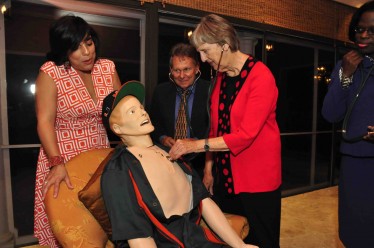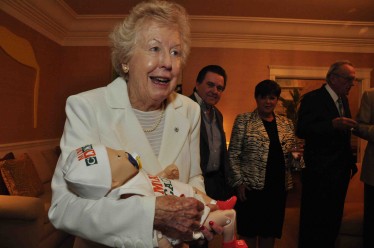
Betty Alvarez, right, and her husband, Marcelo, listen to Laerdal's heartbeat, while UM nurse educator Susana Barroso observes.
The eartips of a stethoscope securely in place, Betty Alvarez pressed the instrument’s diaphragm firmly against Laerdal’s heaving chest and looked downward, leaning slightly forward as if to get a better listen.
“Thump-thump, thump-thump” went the sound coming from Laerdal’s upper torso. Alvarez was astonished. “It sounds just like a real heart,” she exclaimed.
A retired nurse who earned her degree from the University of Miami in 1965 before starting a career as a certified diabetes educator and clinical researcher, Alvarez knows better than most people what a healthy heart—and a sick one—sounds like.
Which is why the heart sounds emanating from Laerdal were even more astonishing, considering that he’s not human.
Made of human tissue-like soft plastic and brought to life by internal software and electronics, Laerdal is one of the UM School of Nursing and Health Studies’ latest patient simulators, a SimMan who can breathe, cry, sweat, register a pulse, catch a cold, and even bleed.
Alvarez, her husband, Marcelo, and a group of more than a dozen donors, trustees, alumni, and community leaders got the chance to examine him—literally—during a private dinner and classroom-like learning experience held on April 21 at UM President Donna E. Shalala’s residence, listening to his chest sounds, taking his pulse, and peering into his pupils.

UM trustee Marta Weeks cares for Baby Hal, one of 17 patient simulators at the School of Nursing and Health Studies.
“Resusci Anne was the first simulator I remember,” Alvarez said, referring to the training mannequin first introduced in 1960 for teaching cardiopulmonary resuscitation. “That was really a milestone back then. Now, it’s a different day and time.”
Laerdal and the 16 other patient simulators that call UM’s nursing school home are changing the way student nurses are trained, teaching them how to catheterize a patient, hook up an IV line, care for a patient with an amputated leg, and even help deliver a baby in distress—all before going into the clinical setting.
“We get theory in the classroom,” said nurse educator Susana Barroso, who helped explain many of Laerdal’s lifelike functions as well as those of Baby Hal, an infant patient simulator, to guests at the event. “Simulation allows us to put it into practice.”
During a semester, as many as 100 nursing students will train on one of the school’s high-tech mannequins over an eight-hour shift, assessing the needs and tracking the condition of the patient at the bedside.
They listen for abnormalities in the heart, chest, and lungs. “I can take off half of his left leg or an arm to simulate an amputation and actually make it bleed,” said Jordan Halasz, director of simulation services, explaining some of the scenarios introduced to test students.
Two of the school’s mannequins can give birth to babies that coo, turn blue, and exhibit a host of other emotions, as UM trustee Marta Weeks discovered when Barroso handed her a crying Baby Hal. Student teams, Barroso explained, may find themselves confronted with a scenario of not only caring for a sick child but also a mother experiencing postpartum hemorrhaging.
They will make their fair share of mistakes, “but the beauty of this is that it’s a simulation, and the students learn from their errors,” said Nilda Peragallo, dean of UM’s nursing school.
To aid in the teaching process, training sessions are videotaped and observed by instructors and other students in a separate room, and teams are debriefed after their shifts end, learning what they did wrong and where they can improve.
“Simulation is revolutionizing the future of health care in this country because it allows both nurses and doctors to have vibrant experiences in health care before they actually go out into the field,” said Kim Greene, executive director of the Dr. John T. Macdonald Foundation, which funds initiatives at the Miller School of Medicine and a network of school health clinics in Miami-Dade. “The ability to learn something and say, ‘I’ll never make that mistake again’ is heightened because they’re in a situation where they know they’re being looked at and critiqued.”







